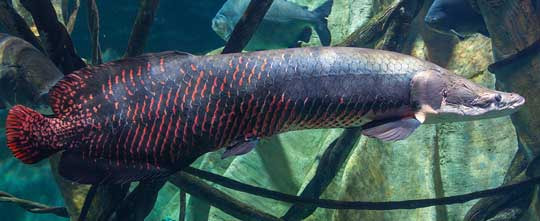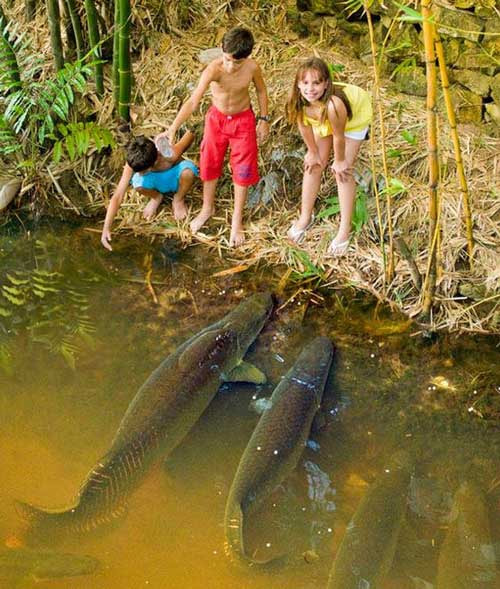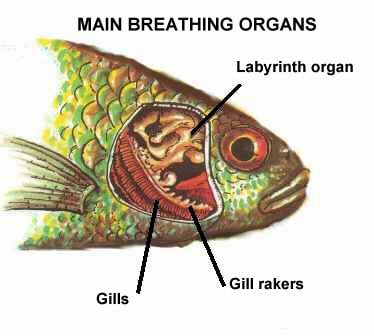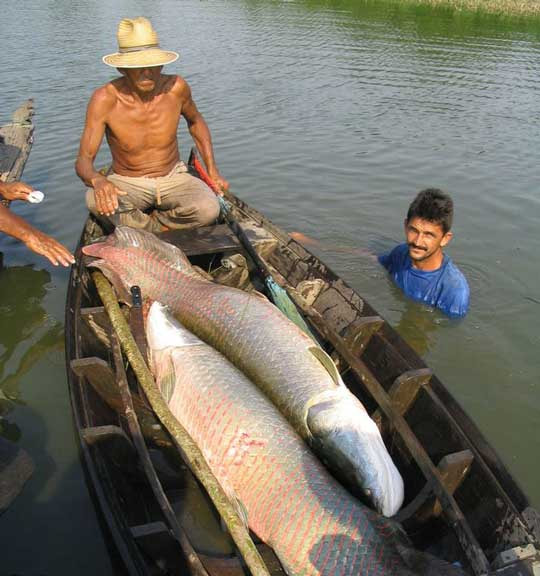|
Hmm... have I featured a fish before? I don't think so. For the first fish featured as an Awesome Animal, I decided to use one most people probably haven't heard of before. The Arapaima is unique because it is the largest fish living in freshwater. Another cool feature—it not only can breathe in water, like most fish, but it is also capable of breathing air! What the heck is an Arapaima? The arapaima, sometimes also called pirarucu or paiche, is a freshwater fish that lives in the rainforest rivers, swamps, and lakes of the Amazon basin of South America. There are several species—up to five—but scientists do not all agree on this, and two of the species are so rare that their existence is questionable. Amazing facts about the Arapaima The arapaima is a big fish. They can grow over 15 feet (4.5 m) long and weigh up to 440 pounds (200 kg). There are plenty of ocean fish that get this large, but the arapaima is the largest fish that lives exclusively in freshwater. Unfortunately, since the arapaima is an important food fish for local fishermen, they have been overfished, and their average size is now smaller, more like 7 feet (2.1 m) and 200 pounds (90 kg). Arapaimas have extremely large scales. Each scale can be 2.4 inches (6 cm) across. As you can see from the photo above, the scales near the tail are often bright red. In fact, the name pirarucu comes from the Tupi language, and the word translates roughly to “red fish.” Speaking of their scales, these large plates have evolved to be piranha proof! Since the arapaima lives in the same waters as piranhas, this is useful don't you think? The large, tough scales are made of mineralized collagen, making them extremely hard. Not only that, but the scales' corrugated shape makes them flexible so they don't break when piranhas bite. Below are some kids feeding arapaima fish at a park. Arapaimas can breathe air. You are probably familiar with the popular pet shop fish sometimes called the Siamese fighting fish (Betta splendens). It is a tiny fish that can live in a very small aquarium without oxygenated water. How does it breathe without much oxygen in the water? The betta fish has an organ called the labyrinth organ, and so does the arapaima. The labyrinth organ is actually an extension of the gill plates (bone that anchors the gills) and is made of many folds of bone. Tiny blood vessels cover these folds and absorb oxygen from the air, kind of like lungs absorb air. This ability to breathe air allows the arapaima to survive during the low water season when bodies of water become isolated and stagnant. This fish can survive in water with almost no dissolved oxygen (as low as 0.5 ppm). Here's another benefit for this fish for having a labyrinth organ. During the low water season, other fish struggle to get enough oxygen from the water, and they become very slow and lethargic. Can you guess what arapaimas eat? Yep, other fish. So, they can gulp the air they need and then cruise around, sucking up all the lethargic fish. Like fish in a barrel, as they say. When an arapaima takes a big gulp of air, it can then stay under water for 10 to 20 minutes before surfacing for another gulp. As you can imagine, they make a loud gulping sound when they do this. Although arapaimas rarely attack humans, these fish have a habit of leaping out of the water when startled. This sometimes results in the massive fish capsizing the small boats that startle them. So, I suppose in that respect they could be considered dangerous. Check out this video of a fisherman catching an arapaima. Because arapaimas must come to the surface to breathe, they are fairly easy for fishermen to catch. The local fishermen often paddle around in their homemade canoes and skewer the fish with harpoons. See the fisherman below with his catch. Unfortunately, arapaimas have been heavily overfished, and they have become extinct in some areas of their range. In other areas, their numbers are dwindling fast. Here's the good news, though. In areas where the government is actively regulating arapaima fishing (setting limits, seasons, etc.), these fish are actually thriving. Yay!!! In my opinion, it is a real tragedy when any species goes extinct, particularly when it is a result of human activity. So, the Arapaime deserves a place in the S.A.H.O.F. (Sterling Animal Hall of Fame). FUN FACT: The word sterling, of course, refers to British money and to sterling silver (or things made of sterling silver). The word originated in about 1300, probably from the Middle English word sterre (meaning star), from the stars that were pressed onto certain Norman coins. In the mid 1500s, the word was broadened to refer to "money having the quality of sterling." Then in 1600 it was broadened again to refer to "English money in general." A pound sterling originally meant a pound of sterlings, which was about 240 sterlings. At some point, the word began referring to "capable of standing to a test" (as a a good quality coin would). Then, finally, people started to use the term as an adjective to mean "genuine and reliable" or "first class." For example, of sterling character, or a sterling record of achievement. So, sterling is another way to say awesome! Photo Credits:
Tree chewed by beaver - Trish Smith Beaver chewing tree - AnimatedFX on Flickr Arapaima #1 - Tennessee Aquarium Children feeding arapaima - Pinterest Diagram of Labyrinth organ - My Aquarium Club Fisherman carrying arapaima - Sergio Ricardo de Oliveira via NBC News Fishermen with two arapaima - Leandro Castello via LiveScience
0 Comments
Leave a Reply. |
Stan's Cogitations
Everyone needs a creative outlet. That's why I write. Archives
July 2024
|






 RSS Feed
RSS Feed